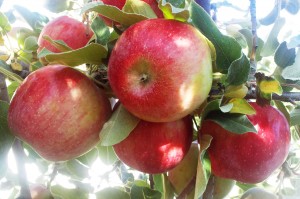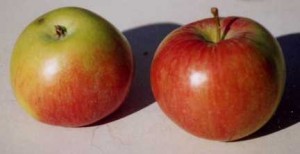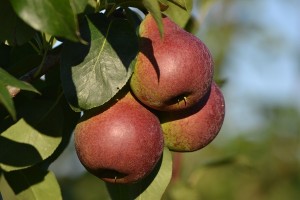Growing Fruit Trees in East Idaho
Growing Fruit Trees in East Idaho
Growing fruit trees in East Idaho can be fun and rewarding. Fruit trees provide beautiful blossoms in the spring, welcome shade in the summer, and bountiful harvests of flavorful fruit. The following information, taken from a gardening tip sheet at www.tcgardens.com, should help you grow fruit successfully in our harsh east Idaho climate.
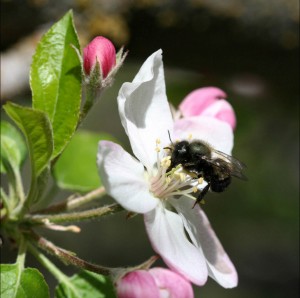 Pollination – Fruit results from pollination of blossoms. Some trees can set an abundant crop with their own pollen, so they are called self-pollinating. Other trees need pollination from another variety. Two trees of the same variety will not pollinate each other, and an apple will not pollinate a peach, etc. You must have two different varieties of the same type of fruit. Bees usually carry out this transfer of pollen. Bees will travel up to 1/4 mile between trees, but it’s best to plant cross-pollinating varieties within 100 feet of each other.
Pollination – Fruit results from pollination of blossoms. Some trees can set an abundant crop with their own pollen, so they are called self-pollinating. Other trees need pollination from another variety. Two trees of the same variety will not pollinate each other, and an apple will not pollinate a peach, etc. You must have two different varieties of the same type of fruit. Bees usually carry out this transfer of pollen. Bees will travel up to 1/4 mile between trees, but it’s best to plant cross-pollinating varieties within 100 feet of each other. 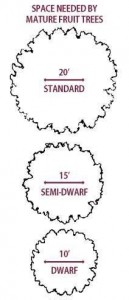 Many neighbors have enough fruit trees to assure plenty of cross-pollination – but if you’re not sure, you should plant your own “pollination partners.” Different sizes of trees can pollinate each other, so a dwarf tree can pollinate with a standard tree and vice versa.
Many neighbors have enough fruit trees to assure plenty of cross-pollination – but if you’re not sure, you should plant your own “pollination partners.” Different sizes of trees can pollinate each other, so a dwarf tree can pollinate with a standard tree and vice versa.
Spacing – Dwarf trees should be spaced about 10 feet apart, semi-dwarf 15 feet apart, and standard about 20 feet apart.
Tree Height – Approximate height of trees: Dwarf trees: 8-10 ft., Semi-dwarf: 12-18 ft., Standard size: 15-25 ft. (Apricots, Peaches and Plums tend to be a bit smaller.)
Hardiness – For a successful backyard orchard, take care to select only the hardiest varieties, or be willing to take a little risk if you want to plant some of the more tender varieties.
Our climate has definitely moderated in recent years, making the growing of fruit trees like peaches much less risky in valley locations. But if you live in some of the colder areas of East Idaho the only reliably hardy fruit trees are probably some of the hardier apples and pie cherries. All other varieties are subject to occasional winter damage or even winterkill during extremely severe winters. Many can be grown successfully, however, with a little extra care… and a little luck. Zone 4 trees are generally hardy in the Idaho Falls area. Some Zone 5 trees do well in Pocatello. Choose Zone 3 trees for colder areas.
Fruit trees listed in order of general hardiness are: Apples, Pie Cherries, American and European Plums, Pears, Sweet Cherries, Apricots, Peaches, Nectarines, and Japanese Plums.
How long until they will produce fruit? Most trees will begin producing fruit in about 2 to 6 years. Dwarf and semi-dwarf apples usually produce sooner than standard varieties. Cherries and peaches often produce the 1st or 2nd year.
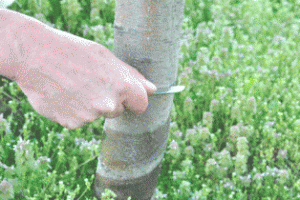 A tree that is over 5 years old and still not blossoming can usually be induced to bloom by cutting completely around the trunk with a sharp knife. (Don’t remove anything, just perforate all the way through the bark). This is best done in late spring to encourage fruit production the following year. More information.
A tree that is over 5 years old and still not blossoming can usually be induced to bloom by cutting completely around the trunk with a sharp knife. (Don’t remove anything, just perforate all the way through the bark). This is best done in late spring to encourage fruit production the following year. More information.
Spring Frosts
To help avoid blossom-killing spring frosts, you can spread mulch approximately 6 inches deep around the base of the tree during the winter. This will hold the cold in the ground and can reportedly delay blooming by as much as one week. This is especially helpful for peaches and apricots.
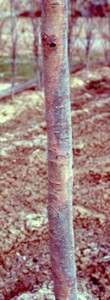 Sunscald
Sunscald
Many fruit trees have tender bark that is susceptible to sunscald. This is a very damaging condition that occurs in the wintertime. One side of the bark is killed because of alternating night/day freezing and thawing. Protecting trees with Tree Saver tree wrap can prevent this damage. Tree Saver is made of a white plastic material that allows the tree to breathe while reflecting away heat and insulating from the cold. Apple trees only need to be protected for their first few winters, after which they will develop a thicker, tougher bark. All other fruit trees should be protected every winter.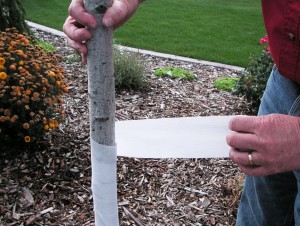
Fall Frosts
Apples will generally tolerate frosts into the low 20’s before damage occurs in the fall. Upper teens can even be tolerated for a couple of hours. However, temperatures this cold can reduce the length of time the fruit can be stored.
Fruit Varieties
Apples – Apples are generally the hardiest fruit trees for East Idaho. However, Granny Smith, Braeburn, Fuji, Winesap, and Rome Beauty are not recommended for our area due to their late ripening. Highly recommended varieties include Honeycrisp and Sweet 16. Apples are generally not self-pollinating. Use two varieties to be productive. Cross-pollination is possible only when varieties bloom at approximately the same time. Length of bloom is usually 7-15 days. Early bloomers should be planted with early or midseason bloomers and late bloomers with late or midseason bloomers. Dwarf trees can produce up to 5 bushels each year. Semi-dwarf and Standard can produce up to 10 bushels.
Apricots – Apricots are generally self-pollinating. Recommended varieties include Chinese (Mormon), and Scout.
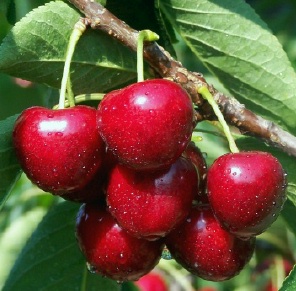 Cherries – Pie cherries are self-pollinating. Most sweet cherries are not. Pie cherries are not reliable pollinatores for sweet cherries because they usually don’t bloom at the same time. Recommended varieties include Montmorency (pie) and Stella (self-pollinating sweet).
Cherries – Pie cherries are self-pollinating. Most sweet cherries are not. Pie cherries are not reliable pollinatores for sweet cherries because they usually don’t bloom at the same time. Recommended varieties include Montmorency (pie) and Stella (self-pollinating sweet).
Peaches – All are self-pollinating. If you decide to try peaches and apricots in east Idaho please be sure to spray regularly because they are a host for the Green Peach Aphid which can spread disease in the potato crop. The hardiest varieties include Red Haven, Contender, and Reliance.
Pears – Generally not self-pollinating. Plant two varieties for best production. Fire blight can sometimes be severe enough to kill pears, so it may be wise to choose a resistant variety such as Summercrisp. Recommended varieties include Parker, Summercrisp, and Bartlett.
Plums – Blue plums are usually self-pollinating. Most others are not. Japanese plums are not reliably hardy in the colder regions of east Idaho. However, Superior, Toka, and Mt. Royal generally do quite well.
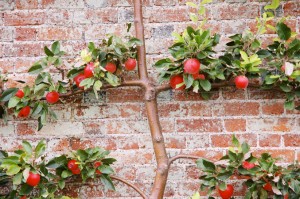 There is nothing so sweet and flavorful as fruit picked fresh from a tree in your own back yard, and the dwarf varieties only need about 10 feet of space. If you have even less space you can always train them espalier style along a fence or building. But however much room you have, you can enjoy growing your own fruit trees, even in Idaho.
There is nothing so sweet and flavorful as fruit picked fresh from a tree in your own back yard, and the dwarf varieties only need about 10 feet of space. If you have even less space you can always train them espalier style along a fence or building. But however much room you have, you can enjoy growing your own fruit trees, even in Idaho.



